
FOUR of the five NYC boroughs have lettered streets, though only Brooklyn carries the idea all the way through. As far as lettered streets go in the USA, Washington, DC’s are probably the most famed, with A Street through W Street, with X, Y and Z skipped; J was also skipped because when Pierre L’Enfant designed and laid out Washington, DC in the 1790s, I and J were still undifferentiated in the alphabet.
Southern Brooklyn uses the Flatbush Town Plan, which was also employed in parts of Flatlands and Gravesend, with east-west lettered avenues and north-south numbered streets called East and West, as they were laid out east and west of McDonald Avenue. The Brooklyn street map evolved confusingly, though; developers such as Dean Alvord, when building areas such as Prospect Park South, preferred to give Avenues A through G British or historic names: Albemarle, Beverl(e)y, Farragut and so on. Thus, as neighborhoods developed independently you have a situation in which Avenues A and B, in East Flatbush where it meets Brownsville, are 5 miles away from Avenue C, in Kensington.
Manhattan’s lettered avenues are less confusing. In 1807, surveyor Simeon DeWitt, merchant and US Senator John Rutherford and US senator, patriot and signer of the Declaration of Independence Gouverneur Morris were tasked with laying out the future roads on the island of Manhattan. They finished in 1811 and presented what is called the Commissioners’ Plan. A younger surveyor, John Randel, equipped only with hand tools, some horses, and excuses to provide to angry landowners finding him on their property, went forth to mark the exact locations where the grid system of Manhattan would be.
Avenues 1 through 12 went from north to south through most of Manhattan. A quick look at the map, though, shows that the island is wider south of 14th Street…enough for four other avenues, which became Avenues A through D. Actually, Avenue A and B also fit uptown in spots; but after some decades, that northern part of Avenue A became Asser Levy Place, York Avenue and Pleasant Avenue, and Avenue B became East End Avenue.
Since I had never done a study of Avenues A through D, I walked A and B in December 2024, and will follow with C and D in due course. Today, I’ll talk about Avenue A, and a bit more.
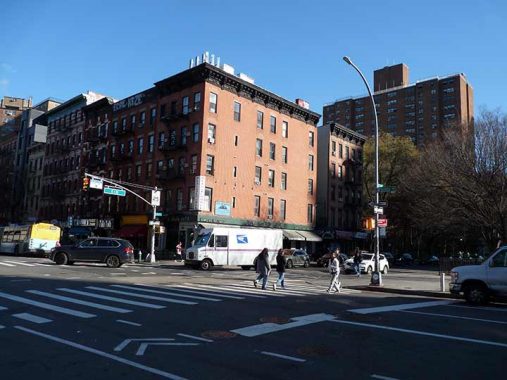
Since the F train leaves you at 1st Avenue and East 1st Street, it’s time to mention a few things, like the Nexus Lounge on the corner. On a Seinfeld episode, Kosmo Kramer, who rarely ventured outside the Upper West Side except to visit Jerry’s parents in Florida, is lost downtown at 1st and 1st, which he says “must be the nexus of the universe.” And who knows, maybe he was right.
Directly across 1st Avenue is a standard issue brick 5 story walkup apartment house…with a small beach house on the roof. I went where I usually go in situations like this, to Nick Carr’s Scouting NY (though he has since moved to Los Angeles, as befits a movie scene scout). He has some nice photos of the beach house with its cupola and weathervane, but no idea about how and when it got there.
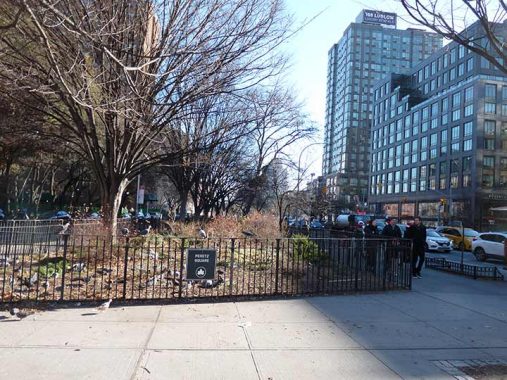
The street grids of the Lower East Side and the East Village are slightly athwart each other and meet at a bit of an angle, divided by East Houston Street. Because of this, both East 1st and 2nd intersect East Houston at very narrow angles. The “needle park” at the narrow angle of East 1st and East Houston is Peretz “Square,” named in 1952 for Isaac Loeb Peretz (1851-1915), an attorney, author, essayist and poet born in Poland under Russian rule. He wrote primarily in Yiddish and was known as the “Great Educator” of the Jewish masses.
A writer of social criticism, sympathetic to the labor movement, he wrote stories, folk tales and plays. Liptzin characterizes him as both a realist and a romanticist, who “delved into irrational layers of the soul”… ; “an optimist who believed in the inevitability of progress through enlightenment”, and who, at times, expressed this optimism through “visions of Messianic possibilities”. Still, while most Jewish intellectuals were unrestrained in their support of theRussian Revolution of 1905, Peretz’s view was more reserved, focusing more on the pogroms that took place within the Revolution, and concerned that the Revolution’s universalist ideals would leave little space for Jewish non-conformism. wikipedia
Both East 1st and East 2nd Streets were recently (in 2014) rerouted by the NYC Department of Transportation so that traffic meets at less of an angle.
#108 East 1st Street at East Houston, according to NY Songlines, used to be a synagogue, the Beth Haknesseth Anshe Padheitze, a Polish congregation, later the Lithuanian Kochob Jacob Anshe Kamenetz Lite. It still has its Star, though today it’s strictly residential.
Is the Hebrew lettering a translation of the above? Comments are open.
Dvorah Kaplan: The Hebrew letters on the building do say. “Beth Haknesset Anshe Padheitze” as you surmised, which means House of Assembly of the Men of (the town of) Padheitze, and the letters on the rusty metal arch translate as, “Present from the Ladies’ Auxiliary.”
Avenue A begins at East Houston as a northern extension of Essex Street. This building on the SE corner contained a furniture store on the ground floor, with large letters proclaiming its presence.
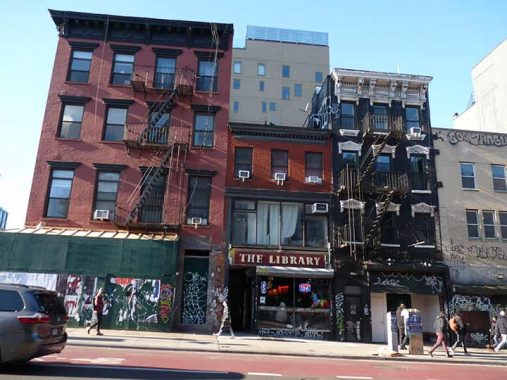
This East Village rock & roll bar is a neighborhood classic. It’s staffed mainly with badass female bartenders covered in tattoos and has a great mix of old regulars and younger people looking for a dive bar. The Library’s jukebox is known for its punk rock jams and the best thing about its beer is how cheap it is. [Thrillist]
There are bookshelves inside, just like my house.
You have plenty of drinkery choices on Avenue A between East 1st and 2nd, as here are a pair of Irish bars, Kelly’s and Conor’s Goat. I don’t know if there’s a story behind the name, but there’s a rendering of a goat on the wall.
I liked Best Housekeeping’s older sign, which had two huge General Electric logos on it. Now, you have to look closely to see them.
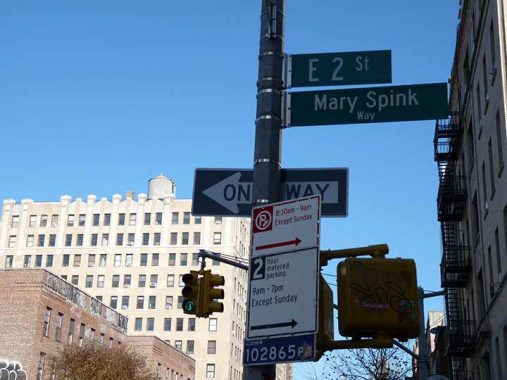
Mary Spink was “was executive director of Lower East Side People’s Mutual Housing Association, a member of Community Board 3 and a board member of the LES Peoples Federal Credit Union. In the last years of her life, she was an important voice for building affordable housing in the former Seward Park Urban Renewal Area.” The street was co-named in 2017. [The Lo-Down]
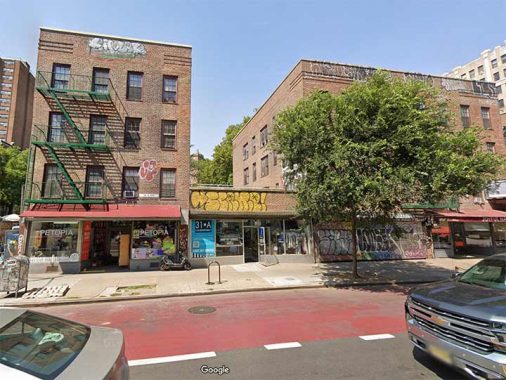
As Forgotten NY readers know, I like brick residential buildings but this grouping along Avenue A between East 2nd and 3rd and then on 3rd Street itself looks pretty nondescript; however, they are nonetheless recognized by the Landmarks Preservation Commission, as when they were built in 1935-1936 (Frederick Ackerman, arch.) they were the first low-income public housing project, known collectively as the First Houses.
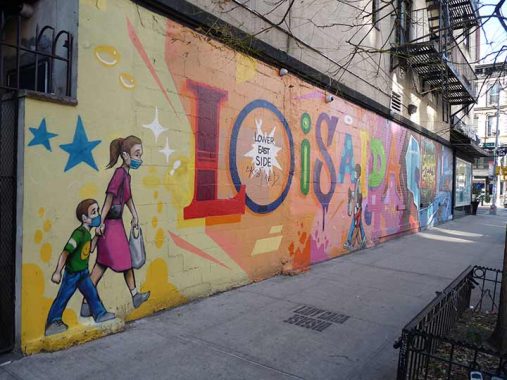
Because of parked sport utility vehicles, photographing this “Loisaida” mural on East 2nd Street isn’y easy. I had to settle for this angular shot.
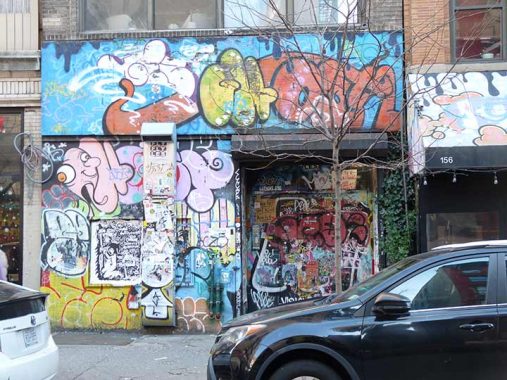
Directly across from the mural on East 2nd is this storefront and on Street View through the years, you can see the “street art” evolve.
A tale of two ghost signs. Unlike other cities NYC has relatively few large vertical signs hanging above sidewalks, but this location on Avenue A between East 2nd and 3rd has had not one but two. Gracefully was a gourmet delicatessen at #28, that closed in 2014 and has been derelict over a decade, awaiting a new tenant. Gracefully occupied the old Op-Art exterior of Burger-Klein Furniture, which acquired the facade around 1960; the new exterior appeared the year the deli closed.
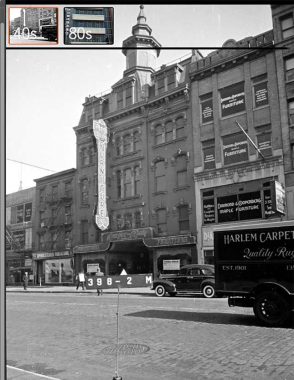
Burger-Klein had a lengthy history on Avenue A, opening in 1936 in the venerable Concordia Hall, a German ballroom that opened in 1871 complete with a cupola. The cupola was lopped off sometime after 1940 and the building has been extensively remodeled at least twice since then. It seems the store had a lengthy tradition of vertical signage.
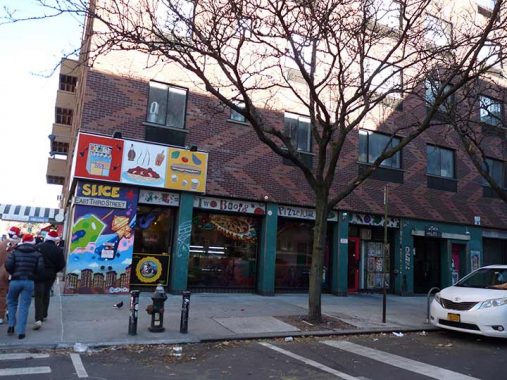
Ever been in a pizzeria/video rental? Two Boots at East 3rd and Avenue A has been that combination for several years, though I’m unsure if the rentals are still there. Two Boots is a pioneer in Cajun-style pizza, adding Louisiana style spices to several pizza recipes. This flagship opened in 1987.
Why Two Boots? Both Italy and Louisiana are shaped like footwear.
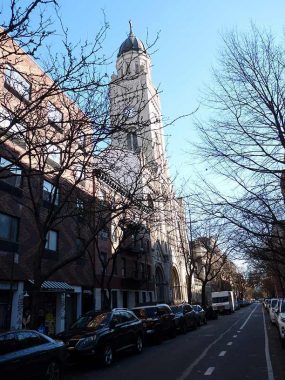
The campanile, or bell tower, of Most Holy Redeemer Catholic Church, 173 East 3rd between Avenues A and B, dominates the East Village skyline. The church is cathedral-sized and believe it or not, the bell tower was once taller than it is today, as its original 250-foot height was lowered to 232 feet in 1912. The parish is one of the oldest in Manhattan, established in 1844 to serve German Catholic immigrants, and the church itself was consecrated by Bishop “Dagger John” Hughes in 1852 — two years after St. Patrick’s Cathedral construction got underway. The church also contains a crypt below ground. Today its services are still bilingual but in English and Spanish. Oddly, there are no signs marking it as MHR outside the building.
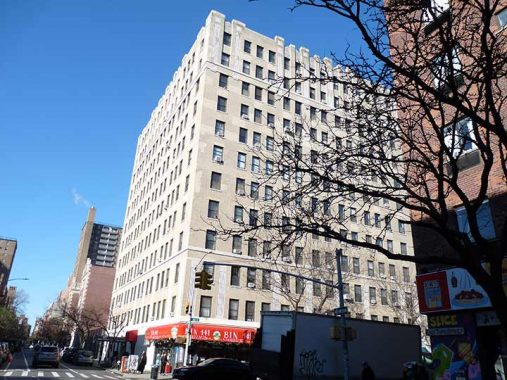
The massive Ageloff Towers, East 4th-5th at Avenue A, constructed with Assyrian details such as winged lions by Samuel Ageloff. in 1928. You can see what the apartments look like at 6 Sq Ft. (You can tell the income level patrons 6 Sq Ft caters to when they call a $725K place a “starter apartment.” (Only Wall Streeters and tech fund people need bid!)
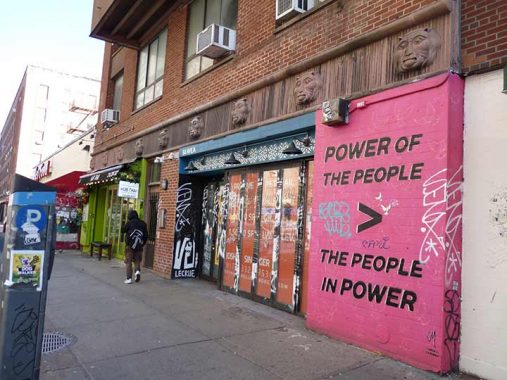
I do not know the story of the lion friezes at #50 Avenue A near East 4th Street; the space has hosted a number of businesses that have retained them.
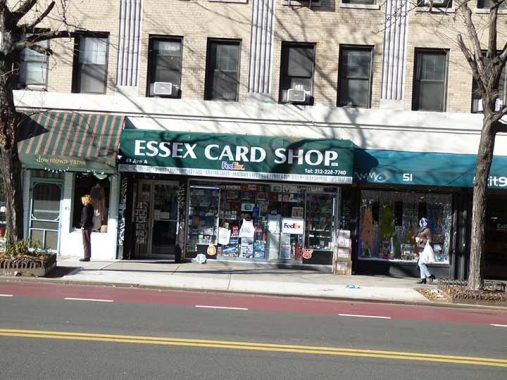
I thought I recognized the name. When the Essex Card Shop moved from its longtime location at #39 Avenue A in the East Village after a 2022 fire to #47 Avenue A a few doors over, its old sidewalk sign was acquired by the New York Sign Museum, which I visited in October 2024. The new awning sign is in Optimum Bold.
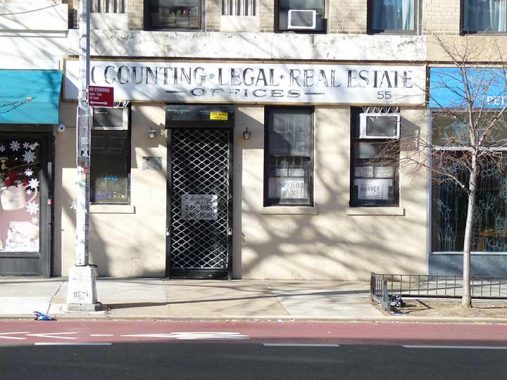
A few doors away at #55 Avenue A is this hand lettered, serifed sign that is considerably sun faded. The Sign Museum could restore it if they were so inclined.
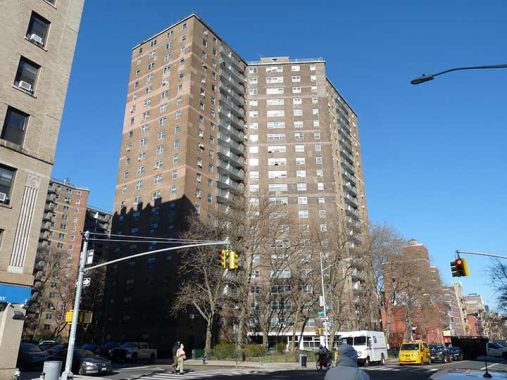
The tallest buildings on Avenue A, and among the tallest in the East Village, belong to the 1,236-unit Village View complex in a group of buildings 16 and 21 stories tall, completed in 1964, occupying most of two blocks between 1st Avenue, Avenue A and East 4th and 6th Streets.
The liquor store at Avenue A and East 4th has changed and not for the better, in my opinion. The wines are still lined up in the window; but that magnificent sign with lettering reminiscent of that seen in western movies I saw there in 2021 is gone.
At #101 Avenue A between East 6th and 7th, we wander into club territory, of which I know little, so I’ll turn it over to Jim Naureckas in NY Songlines:
[Baker Falls] was the Pyramid Club, whose flourishing drag scene produced such cross-dressing phenoms as RuPaul, the Lady Bunny, Lypsinka and Wigstock; it also made rock history in June 1989 as the site of Nirvana’s first New York show, and has hosted such bands as They Might Be Giants, Gun Club, Sonic Youth, Red Hot Chili Peppers (their New York debut), Beastie Boys and Fischerspooner.
Nina Hagen mentions it in her song “New York New York.” Madonna held her first AIDS benefit here. Neighborhood artistes like Ann Magnuson, Steve Buscemi and Karen Finley have premiered works here. Nico of the Velvet Underground used to live in the loft upstairs.
The creatively detailed building dates to 1876, designed by William Jose and originally serving as a meeting hall/restaurant for the German immigrant community– variously known as Kern’s Hall, Shultz’s Hall, Fritz’s Hall and (for a 30-year stretch) Leppig’s Hall.
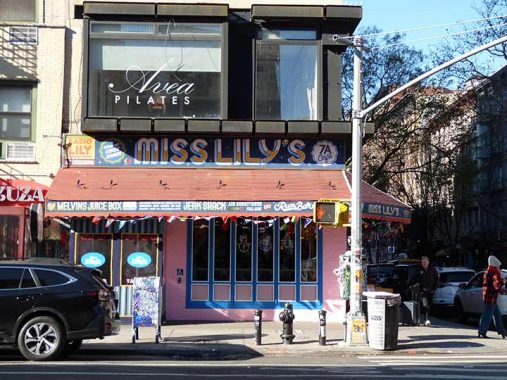
Miss Lily’s 7A Cafe, named for the cross streets, is a Jamaican-themed restaurant with interesting painted sidewalk sign: handpainting is a new trend in sidewalk signage.
Miss Lily’s has built an accessible brand of juice, jerk chicken, and rum punch that’s fun for the whole family, assuming your family is made up entirely of Instagram-obsessed urban skateboarders. They jack the reggae-electro beats high and cover the walls with colorful old vinyl and Jamaican concert posters. Miss Lily’s still has more downtown swag than most, and it’s a no bullsh*t good time. Plus, this food is really good. [The Infatuation]
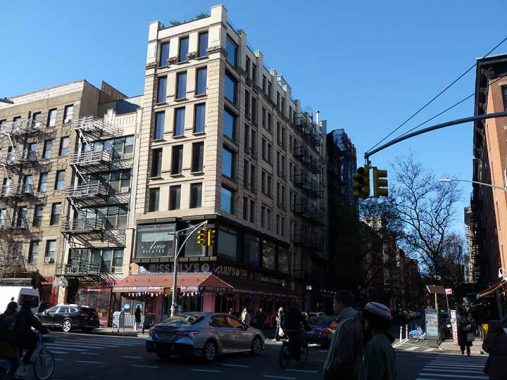
Handsome Moderne corner building at Avenue A and East 7th above Miss Lily’s.
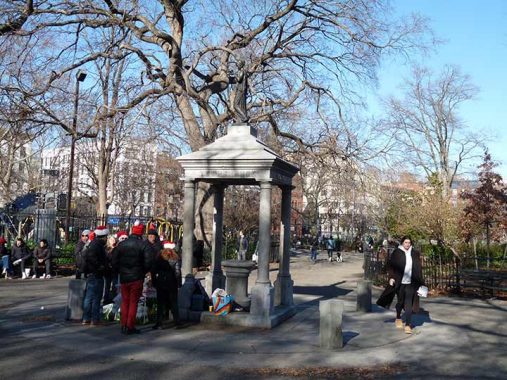
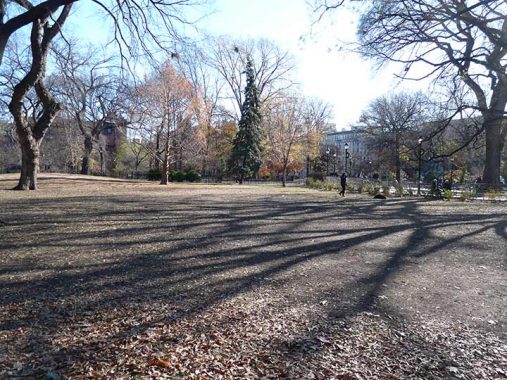
Though Tompkins Square Park borders Avenue A between East 7th and 10th Streets, I believe I have covered it adequately in FNY in the past (scroll through here and you will find several posts) so, other than a brief rest on a bench, I pretty much passed it by. When I attempted a photo of the square’s Temperance Fountain, a gaggle gathered in front of it motioned at me and I assumed they were shooing the scuttler with the camera away; instead, it was a group of carolers who desired a group photo, and I was happy to oblige during the Christmas season.
These are the best photos to date I have gotten of Sam Cox; usually, he’s in the shade. Louise Lawson’s sculpture of Ohio Congressman Samuel Sullivan Cox has stood at Tompkins Square’s southwest corner at Avenue A and East 7th Street since 1924, after its initial placement at the triangle formed by Lafayette Street, 4th Avenue, and Astor Place in 1881. S.S. Cox (1824-1889) was a Democratic Party member of the House of Representatives from Ohio from 1857-1865, and from New York from 1869-1889, when he retired. He championed the Life Saving Service, which patrolled the coast looking for shipwreck survivors; the Service became part of the US Coast Guard in 1915.
He is remembered with a statue, placed while he was still in Congress, for his involvement with the US Post Office. He introduced legislation that assured paid benefits, 2 weeks’ vacation, and a 40-hour work week—progressive in that era—for postal workers. Letter carriers from 188 cities inscribed on the monument raised $10,000 for its creation.
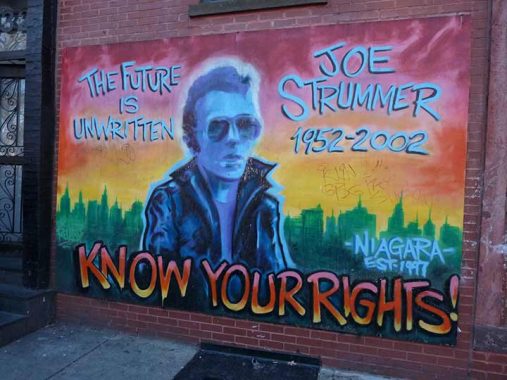
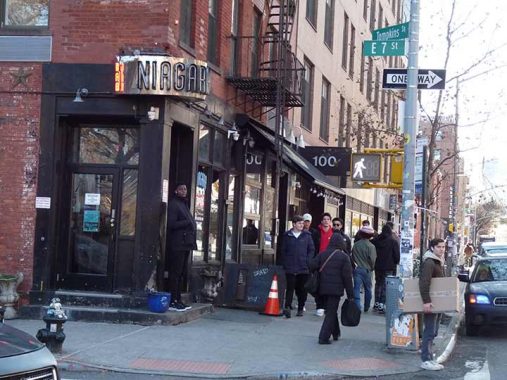
Cox’ statue stands across the street from a likeness of a man from a completely different place and time. John Mellor, known professionally as Joe Strummer (1952-2002), was the founder of “The Only Band That Matters,” the Clash. Of British parentage, he was born in Ankara, Turkey, as his father Ronald served in the British foreign service.
The Clash was of the most overtly political, explosive, and exciting bands of the late ’70s and early ’80s, with their music taking on Nazism, racism, unemployment, and police brutality. They achieved success in the US with the double LP London Calling and singles such as “Train in Vain” and “Rock the Casbah,” but their chief legacy was as a killer live act—they played the old, non-air-conditioned Bonds clothing store in Times Square for 17 straight days in June 1981, one of which I attended, though I know people who were at all of them. After the Clash’s breakup, Strummer did solo work and also played with the Pogues and the Mescaleros. He died of heart failure at age 50.
The artwork here at Avenue A and East 7th Street was originally painted outside the Niagara, a bar Strummer frequented, in 2003, several months after his death, by graffiti artists Dr. Revolt and Zephyr. When the wall was in danger of collapse and had to be replaced in 2013, the artists were called back in to create a new mural. The artists renew the memorial every so often.
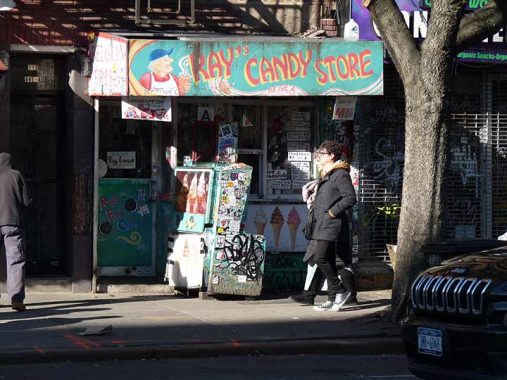
Ray Alvarez (1933- ) has operated Ray’s Candy Store since 1974 and has gradually expanded the menu to serve parkgoers, featuring comfort food like ice cream, hotdogs, and the like.
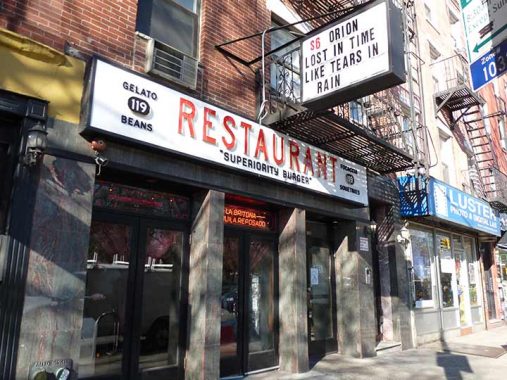
Ukrainian restaurant Odessa had been an East Village fixture since 1965, closing for good in 2020, a victim of the Covid pandemic. Its replacement was Superiority Burger, which is actually vegetarian though the sign doesn’t indicate that feature. The sign partly quotes the android Roy Batty (Rutger Hauer) in “Blade Runner”:
I’ve seen things you people wouldn’t believe. Attack ships on fire off (the) shoulder of Orion. I watched C-beams glitter in the dark near the Tannhäuser Gate. All those moments will be lost in time, like tears in rain. Time to die.

St. Dymphna, according to tradition, lived in Ireland in the 7th Century and was martyred at age 15 by her father, King Damon, who desired an incestuous relationship. She is the patron saint of nervous disorders and mental illnesses. The bar St. Dymphna’s relocated during the past few years from St. Mark’s Place. They may have to work on that B rating though.
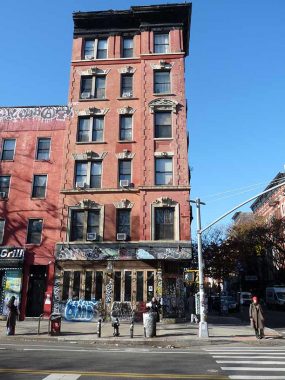
Somewhere under the “street art” on the ground floor of this venerable building with great views of the park at St. Mark’s Place is Mexican restaurant Empellon Al Pastor.
I have never been in Doc Holliday’s, named for the Old West dentist-gunfighter, at Avenue A and East 9th. However, I have been a guest on the NYC-themed podcast hosted by historian Kevin Fitzpatrick and historian/bartender Joanna Leban. Remember, Holliday’s is cash only.
I never noticed it before, but I have been getting even more hawkeyed as the years roll on. The building at the NE corner of Avenue A and East 10th, with more park views, features what is likely the name of the builder on the cornice, Chas. J. Smith. Note the unique “A,” on Avenue A of all streets. The ground floor features the Horus Cafe, named for an ancient Egyptian god.
When the Saint Nicholas Carpatho Russian Orthodox Greek Catholic Church, Avenue A and East 10th was constructed in 1883 the Gothic Revival building was a chapel for nearby St. Mark’s Church at 2nd Avenue and East 10th, but it was purchased by Eastern Orthodox faithful in 1925. The architect was James Renwick Jr., a pre-eminent ecclesiastical architect best known for St. Patrick’s Cathedral on 5th Avenue.
Note the St. Mark frieze on the 10th Street side. The winged lion is a symbol of the, according to tradition, Gospel composer.
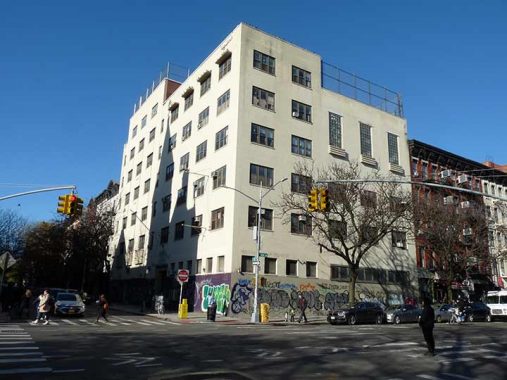
The off-white is nice, the ground floor, not so much. The Boys’ Club of New York, founded by E.H. Harriman, was headquartered in this location from 1901-2022, when the Boys moved to Harlem and Flushing. Since then, every street artist in the neighborhood has used the ground floor for target practice.
[See Comments for the latest info on this building.]
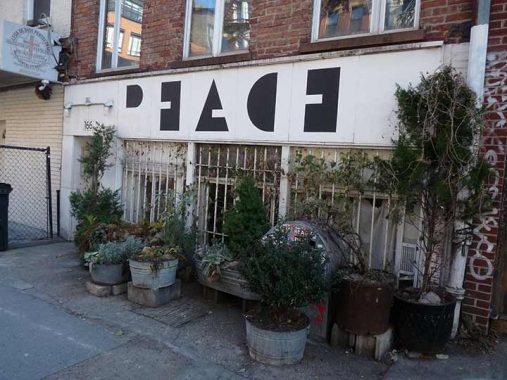
A sign of peace has been on the ground floor at #166 Avenue A for many years. Unusually, the letters are formed by filling in the spaces between the letterstrokes.
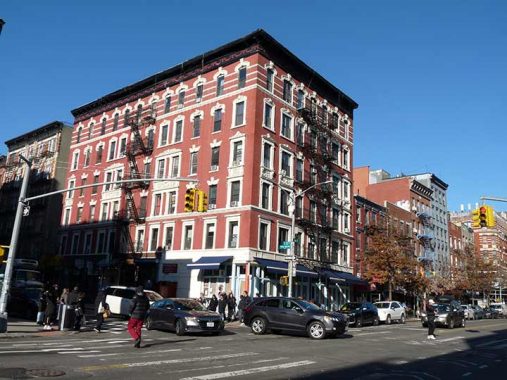
An example of what I call “casual elegance” at Avenue A and East 12th Street.
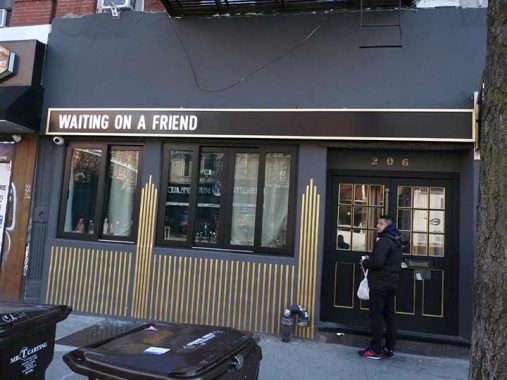
Waiting on a Friend, #206 Avenue A, is not the same bar that Mick Jagger and Keith Richards visit during the video for their 1981 hit “Waiting on a Friend.” That bar is (in 2024) The Lions and is at 1st Avenue and St. Mark’s Place, a short distance away. In the video, the Glimmer Twins sit on the stoop at #98 SMP, which was also used for the cover of Led Zeppelin’s 1975 Physical Graffiti LP.
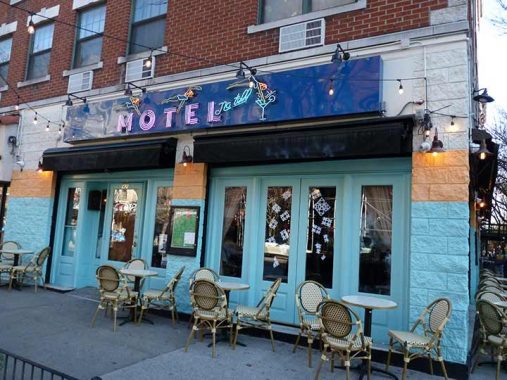
Some nifty neon, or is it LED? at Motel No Tell, Avenue A and East 13th.
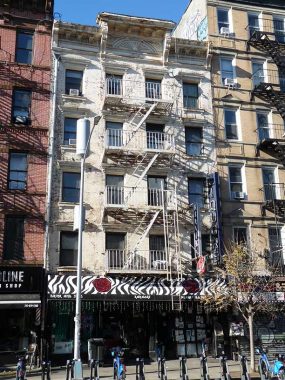
Zebra stripes on an aged building, near Avenue A’s north end at East 14th.
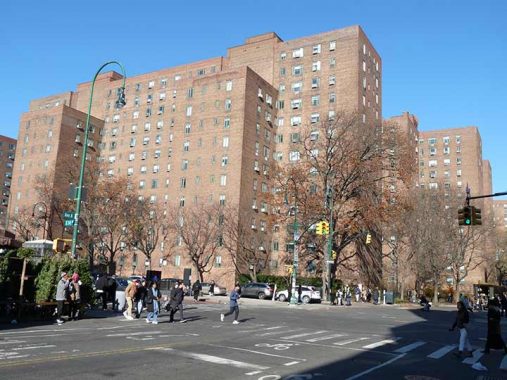
Stuyvesant Town sits on an almost-square defined by East 14th and East 20th Street, 1st Avenue and Avenue C, with 89 buildings containing 8,757 apartments. By auto it’s accessed by a series of ovals located on its four border streets, and pedestrians can easily access its four “quadrants” via the center oval. A second residential complex, Peter Cooper Village, sits north of East 20th Street.
I have a personal connection to Stuyvesant Town — my father worked here as a custodian for 30 years, between 1958 and 1988; he only retired when he turned 70. This was an era in which unionized jobs with ample benefits were … somewhat more attainable than now. He would work the usual Monday through Friday, but occasionally he would work the weekend and take Wednesday and Thursday off, on which days he would see me off to school. It was a long way with two trains from Bay Ridge to Stuyvesant Town, so he would leave the house at around 7 AM or even before that, before I got up, usually arriving home around 7 PM. During snowstorms he would need to go in at off hours to shovel snow.
What’s surprising is that I never visited Stuy-Town when he was working there (I do recall heading over there an evening or two by car when one of my father’s friends drove us there). The old man never helped put me on the famed list of people waiting for apartments to open up, but as he’d probably say now if he was still around, “You didn’t ask me!” My whole trajectory would have changed, as I have occupied Brooklyn and Queens for over 67 years now.
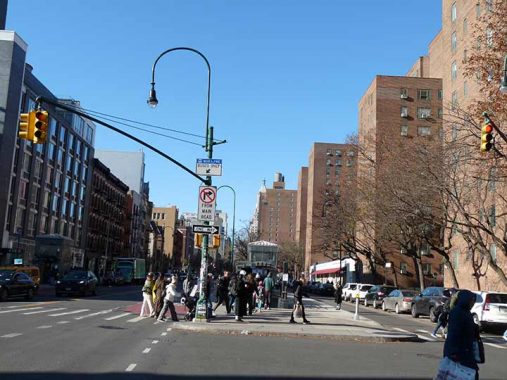
“Bigloop” lampposts appeared on 14th Street in the early 1990s, before Bishop Crook retro versions were widespread, and may have been the Department of Transportation’s way of approximating the Crooks. This one is attached with brackets to a stoplight, an unusual arrangement.
When furtively scuttling around Stuy Town (I feel like I’m trespassing though there are no gates or signs) I still half expect to see the old man’s ghost pushing a cart or wielding a shovel. I went around the 14th Street Loop before emerging at Avenue B and heading south, but that walk will wait for another day.
Stuyvesant Town remains NYC’s premier depository for Type G castiron lampposts, many with their original fire alarm indicator lamp brackets (which aren’t reproduced in modern Bishop Crook and Corvington retro versions).
As always, “comment…as you see fit.” I earn a small payment when you click on any ad on the site. Take a look at the new JOBS link in the red toolbar at the top of the page on the desktop version, as I also get a small payment when you view a job via that link.
1/5/25

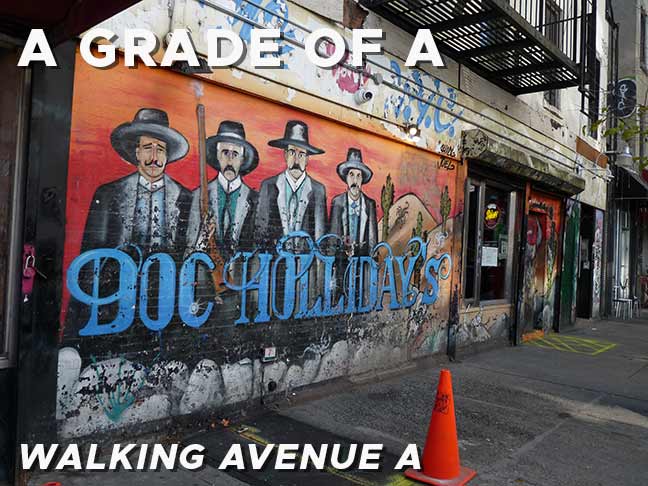
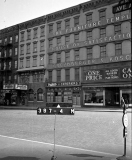

10 comments
Nice overview of my long time stomping grounds. Two things to add. Bakers Falls, occupying the old Pyramid Club space, has fallen and is now co-owned by a successful Brooklyn based club owner and the Knitting Factory. By chance I caught the painting over of the sign in your photograph a few days ago. The new name is “Night Club 101”. Guess the intended audience are the pervasive college students that now permeate the neighborhood and pay the ridiculously high rents.
Second, I don’t know about now but many years ago (over a decade and a half) I met the owner of most (if not all) of the bars on A between 1st and 2nd streets. Offhandedly during our conversation I wondered when he purchased one of the bars since it changed its name recently and was completely renovated. He said that he’s owned it for years and will rename and renovate his bars if patronage seems to be on a long term decline. When it reopens people will flock in to soak up the new, trendy atmosphere. But he said he’ll never change The Library which it hasn’t since I had that conversation. The others changed frequently but Double Down has remained that way for a while. Guess it’s keeping a steady clientele.One place now called the “Wiggle Room” reopened a couple of years ago. However, I don’t know if he owns Kelly’s which can become a very loud sports bars given the correct event or if he even owns any of the bars on the stretch anymore.
The Hebrew letters on the building do say. “Beth HaknessetAnshe Padheitze” as you surmised, which means House of Assembly of the Men of (the town of) Padheitze, and the letters on the rusty metal arch translate as, “Present from the Ladies’ Auxiliary.”
I still have my postcard of the two boys rowing a boat on the flat roof of
the Boys Club.Must have been a real downpour
I’d hate to be the receptionist for the church on Avenue A and 10th: “Good afternoon, Saint Nicholas Carpatho Russian Orthodox Greek Catholic Church, how may I direct your call?”
What’s not mentioned about Stuyvesant Town is that it has possibly the only service roads in Manhattan when you can easily find these in the outer boroughs in many other areas.
The Metropolitan Life Insurance Company owned Parkchester (the Bronx), Stuyvesant Town & Peter Cooper Village (Manhattan). Met Life took advantage of a tax loophole which was the incentive to build middle-income self-contained developments. I was born & raised in Parkchester. All three are nearly identical & it’s nice to see how well-maintained Stuyvesant Town remains to this day. I’m pleased to see that the present owner of Stuyvesant Town continues the tradition of having flag poles placed so that the American flags can be displayed prominently where residents can see & admire them, as it was when I lived in Parkchester so many years ago. It provides quite a contrast to the rest of the area where American flags are more likely to be burned (NO, THAT’S NOT “PROTECTED SPEECH!”) than respected & admired. USA! USA!
The former Boy’s Club of New York building was leased by The Joyce Theater Foundation in 2023. This month they are re-opening it as the New York Center for Creativity & Dance.
There’s more info about the former owner of the PEACE house at 166 Avenue A here: https://www.nytimes.com/2024/08/03/arts/anton-van-dalen-dead.html
We lived in Sty-Town from 1958 – 1962. I remember a very large asphalt-topped playground in between several buildings. It had basketball courts and two huge shower heads, one on each end, that in the summer
became sprinklers. There were a number of cops who lived in our building as well as people who worked at Beth Israel hospital.
Considering DC has a “1/2” street, and there’s a 6-1/2 Avenue in Manhattan – granted, a pedestrian walkway, but still – I’d be thrilled if someone were to give streets on the other side of 1, 2, 3, etc. not a direction in front of it (e.g., not North 1st, 2nd, 3rd) as a differentiator, but a negative sign (-1, -2, -3 streets….)
I used to live on the corner of 12th street and Avenue A around 1992. Great times for this neighborhood. My neighbors were
Allen Ginsberg (I could see him at his desk from my window) and Richard Hell ! Pictures of this ear on my blog:
http://www.nyc90s.com